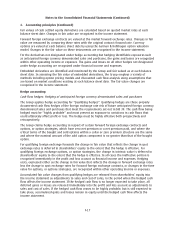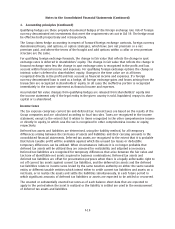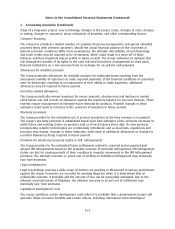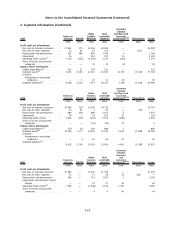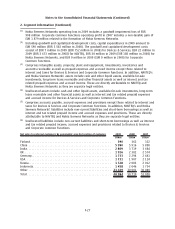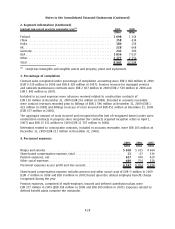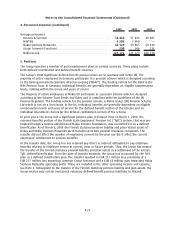Nokia 2009 Annual Report Download - page 198
Download and view the complete annual report
Please find page 198 of the 2009 Nokia annual report below. You can navigate through the pages in the report by either clicking on the pages listed below, or by using the keyword search tool below to find specific information within the annual report.1. Accounting principles (Continued)
volatility and expected life of the options. Nonmarket vesting conditions attached to performance
shares are included in assumptions about the number of shares that the employee will ultimately
receive relating to projections of net sales and earnings per share. Significant differences in equity
market performance, employee option activity and the Group’s projected and actual net sales and
earnings per share performance, may materially affect future expense. See also Note 23.
New accounting pronouncements under IFRS
The Group will adopt the following new and revised standards, amendments and interpretations to
existing standards issued by the IASB that are expected to be relevant to its operations:
IFRS 3 (revised) Business Combinations replaces IFRS 3 (as issued in 2004). The main changes brought
by IFRS 3 (revised) include clarification of the definition of a business, immediate recognition of all
acquisitionrelated costs in profit or loss, recognition of subsequent changes in the fair value of
contingent consideration in accordance with other IFRSs and measurement of goodwill arising from
step acquisitions at the acquisition date.
IAS 27 (revised), “Consolidated and Separate Financial Statements” clarifies presentation of changes in
parentsubsidiary ownership. Changes in a parent’s ownership interest in a subsidiary that do not
result in the loss of control must be accounted for exclusively within equity. If a parent loses control
of a subsidiary it shall derecognize the consolidated assets and liabilities, and any investment
retained in the former subsidiary shall be recognized at fair value at the date when control is lost.
Any differences resulting from this shall be recognized in profit or loss. When losses attributed to the
minority (noncontrolling) interests exceed the minority’s interest in the subsidiary’s equity, these
losses shall be allocated to the noncontrolling interests even if this results in a deficit balance.
IFRS 9 will change the classification, measurement and impairment of financial instruments based on
our objectives for the related contractual cash flows.
Amendments to IFRS 2 and IFRIC 11 clarify that an entity that receives goods or services in a share
based payment arrangement should account for those goods or services no matter which entity in the
group settles the transaction, and no matter whether the transaction is settled in shares or cash.
Amendment to IAS 32 requires that if rights issues offered are issued pro rata to entity’s all existing
shareholders in the same class for a fixed amount of currency, they should be classified as equity
regardless of the currency in which the exercise price is denominated.
Amendments to IFRIC 14 and IAS 19 address the circumstances when an entity is subject to minimum
funding requirements and makes an early payment of contributions to cover those requirements. The
amendment permits such an entity to treat the benefit of such an early payment as an asset.
IFRIC 19 clarifies the requirements when an entity renegotiates the terms of a financial liability with
its creditor and the creditor agrees to accept the entity’s equity instruments to settle the financial
liability fully or partially. The entity’s equity instruments issued to a creditor are part of the
consideration paid to extinguish the financial liability and the issued instruments should be measured
at their fair value.
In addition, there a number of other amendments that form part of the IASB’s annual improvement
project which will be adopted by the Group on January 1, 2010.
The Group will adopt IFRS 3 (revised), IAS 27 (revised) and the amendments to IFRS 2 and IFRIC 11,
IFRIC 14 and IAS 19 and IAS 32 as well as the additional amendments that form part of the IASB’s
annual improvement project on January 1, 2010. IFRIC 19 will be adopted on January 1, 2011. The
F24
Notes to the Consolidated Financial Statements (Continued)





